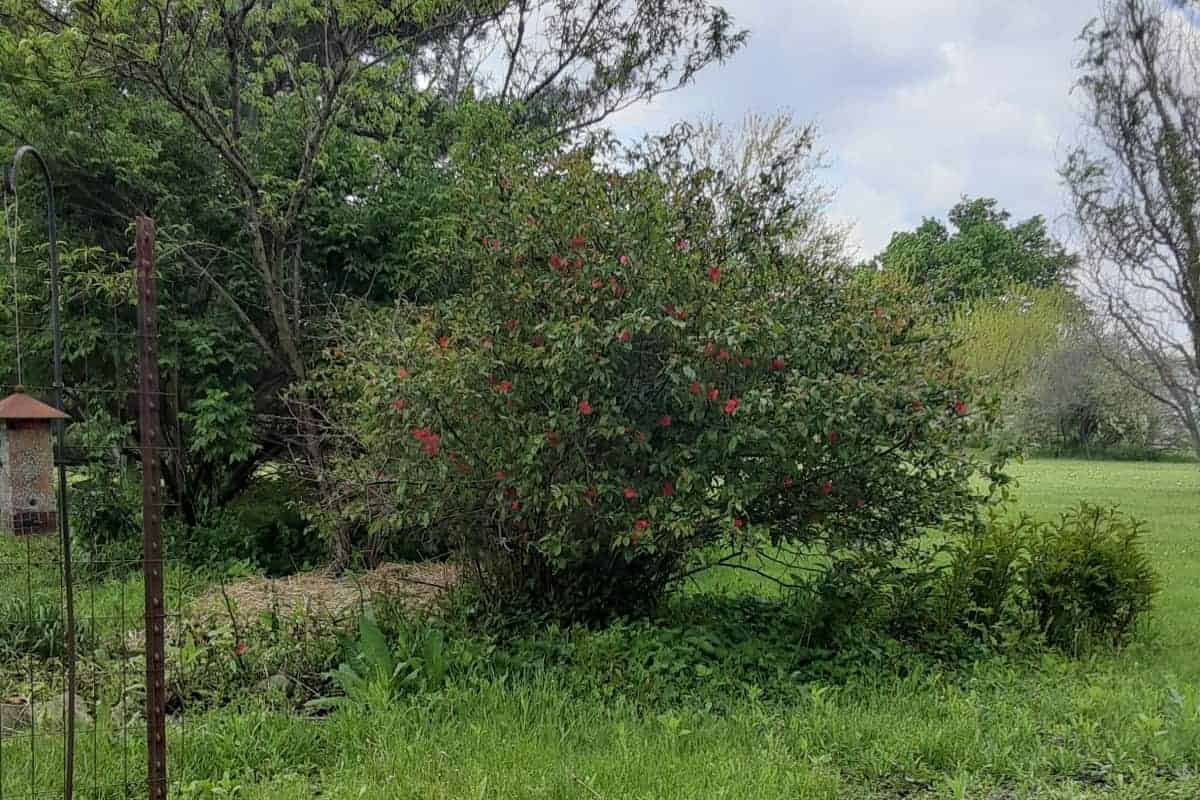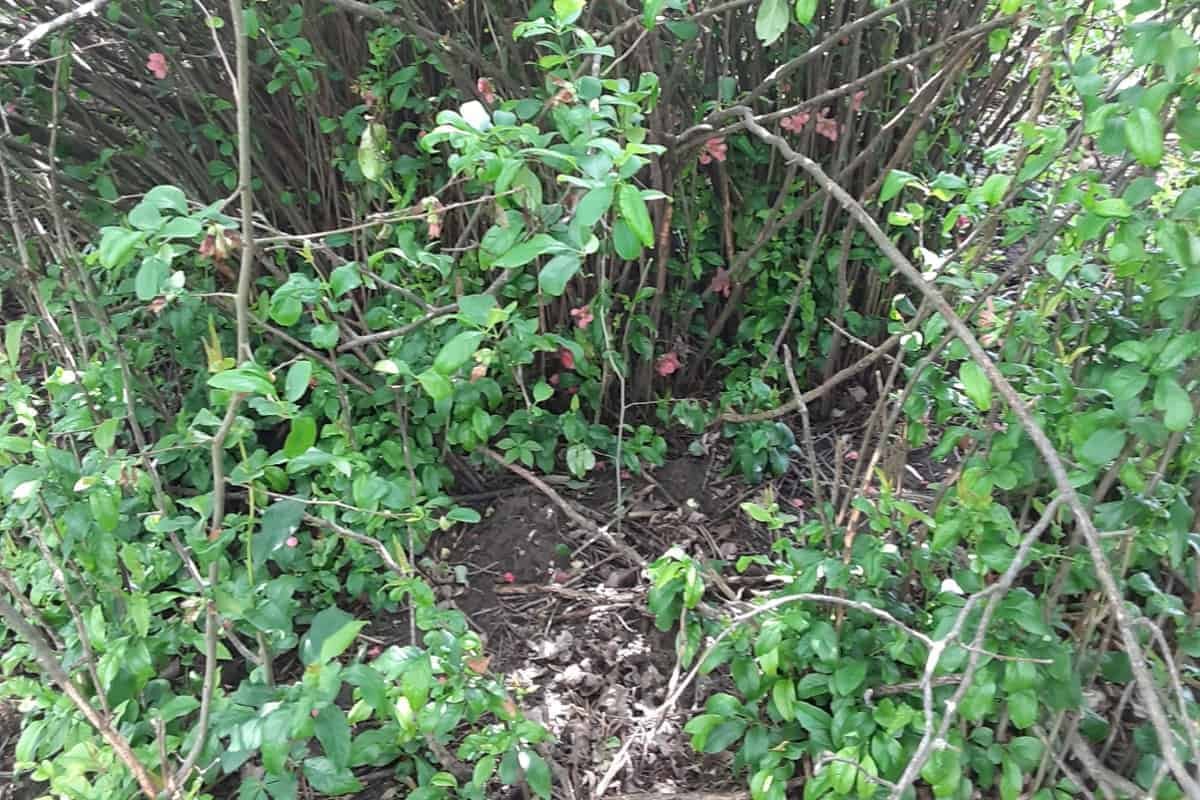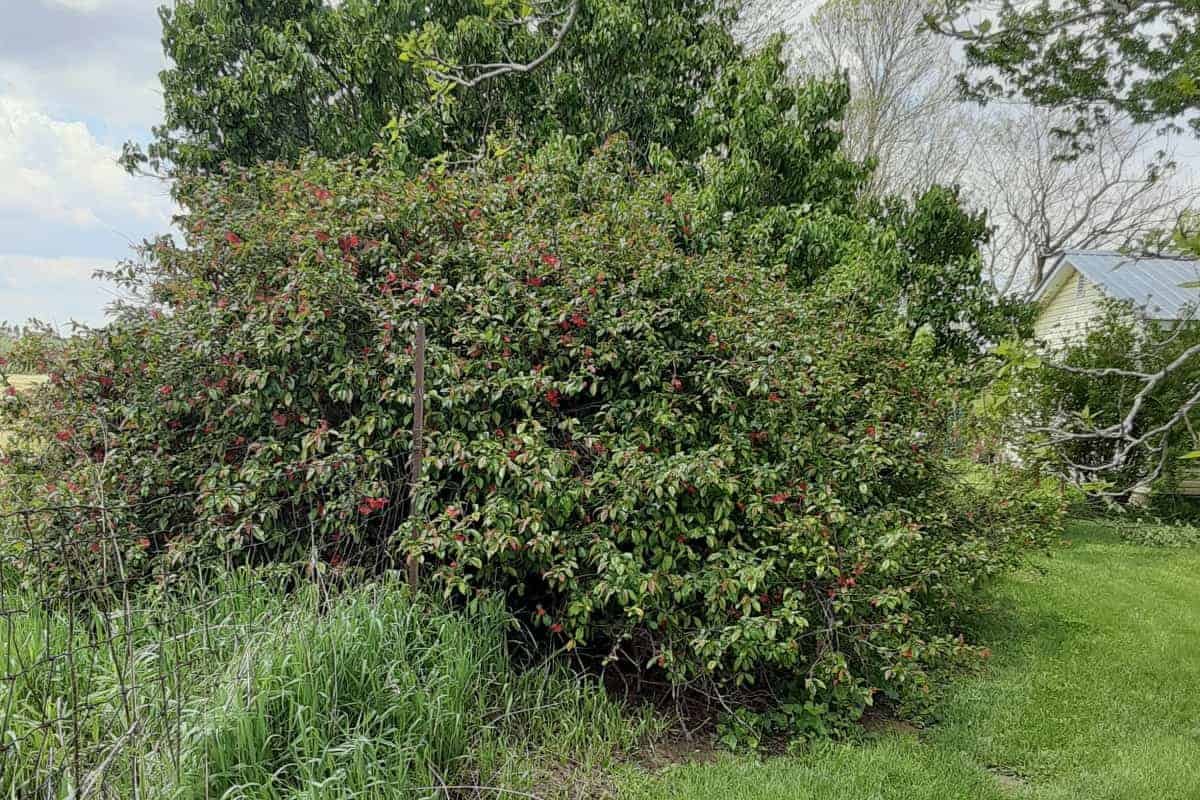Flowering Quince is not listed as invasive on any state or federal list. It does not self-seed into other areas of your yard. What it does do is spread out from the roots 2-3 feet around the base, but not usually aggressively. This makes it the perfect shrub in the back of a border garden as a hedge.
I’m going to show you 3 shrubs located in different parts of my yard, what their spread looks like, and one way that I (somewhat) control them. One is 30 plus years old and the other two are around 13 years old. They are in full sun, partial shade and one is too close to a building.
If you have sharp edge lines in your beds, you might find that Flowering Quince’s wanderings to be a bit irritating when they are older. I have a little gulley at my edges and it will creep right in there and mess up the edge!
Table of Contents
Chaenomeles speciosa: A Perfect Shrub for A Hedge
If you want a living fence, this shrub will give you that and more. With its beautiful spring flowers, 8 -10′ height, and thick growth pattern, you’ll also have privacy. A thorny hedge will discourage “passing through” once someone or a large animal realizes they are there.
Flowering Quince can be hands off most of the time if you don’t try to control its spreading. You will still need to attend to broken branches and any insect infestations or diseases.

10′ Tall x 17′ x 19′. The original shrub has expanded to included 3 extra clumps from suckers. As you can see, just right of center, heavy shade slows the spreading down significantly.
You won’t have a hedge overnight if you are just starting out. The suckers from my Quinces, when transplanted, don’t reach full height for 7-10 years. Every year it blooms, the stunning pink to red flowers make the wait easier.
It pairs well with other early spring flowering shrubs in a hedge like Forsythia and Lilacs. Early blooming flowering Dogwood and Magnolia trees in the front of your hedge add more height and interest!
Controlling The Spread of Flowering Quince
You cannot stop the natural spread of Flowering Quince but you can control it a little bit. In my garden, the spread seems to generally be around 2 feet. Young plants don’t seem to spread much but they do increase as the plant ages.
Some of my research indicated not pruning would result in no suckers. I do not find that to be true in my garden. The shrub in the images below has never been pruned and it suckers readily.

Approximately 8′ tall in early May. Height has significantly been reduced due to heavy shade compared to another of the same age with more sun.

Mowing
Mowing in front of the hedge keeps it in check here. I imagine circling it in the middle of a yard would keep it contained too. We don’t have an edge on the bed for this hedge, so I’ve learned to appreciate Quince’s meanderings and stopped fighting it.
Discing
There is a farm field on the backside so the plowing keeps it from spreading out on that side. A tiller would give the same result if you had a vegetable garden next to it.

Between the discing and the mowing, it can only spread one way.
I encourage it to keep continuing along the fence line to make the hedge longer.
Cutting
There’s a lot of water runoff from the patio for my shrub that’s too close to the shed. I think the extra water encourages it to branch out even more. I cut the new growth down just under the ground in this area to stop it from becoming its own adult version.
I mentioned earlier, these Quince shrubs sucker more as they age and are pruned. Years of trying to control them seem to increase their vigor to grow more!
Heavy Shade
Flowering Quince does best in full sun. Heavy shade affects the height and the spread in my garden. The shade doesn’t stop it completely but majorly slows it down. It will always be looking for the most sunlight and head in that direction. The two in my back yard are roughly the same age and shade has shortened one shrub by half.
Flowering Quince Varieties and Spreading
Quince has 4 different hybrids with many cultivars with some having different growth patterns than their parent Chaenomeles speciosa. If your shrub is Chaenomeles californica , Chaenomeles clarkiana, Chaenomeles superba, or Chaenomeles vilmorinian you may not have the same results as I do. Even the species cultivars have different growth patterns.
Can You Plant Quince Near a Foundation?
In general, it is not recommended to use Flowering Quince shrubs as a foundation plant because of their inherent need to expand. Airflow is needed between all building foundation plantings. This shrub will eventually fill any space that you give it between itself and your house.

In the image here, this shrub is growing too close to my shed. I potted up a small cutting, sat it next to the shed, and promptly forgot about it. The next year it looked really nice there, so I left it. In year three, it busted the pot and dug in like it wasn’t leaving. That’s a good indication of its hardiness, being in a plastic pot over winter with freezing temperatures.
There are three reasons why this shrub is in a bad spot:
- It’s rubbing against the building – is there any wood left I wonder?
- Constant trimming next to the path – thorns hurt
- Wants to grow between stone path – maintenance, yuk
It really needs to be gone but it hurts to lose a plant! Plus, it seems really happy there. What was the hardest plant, tree, or shrub you had to let go of?
Links you might find interesting:
